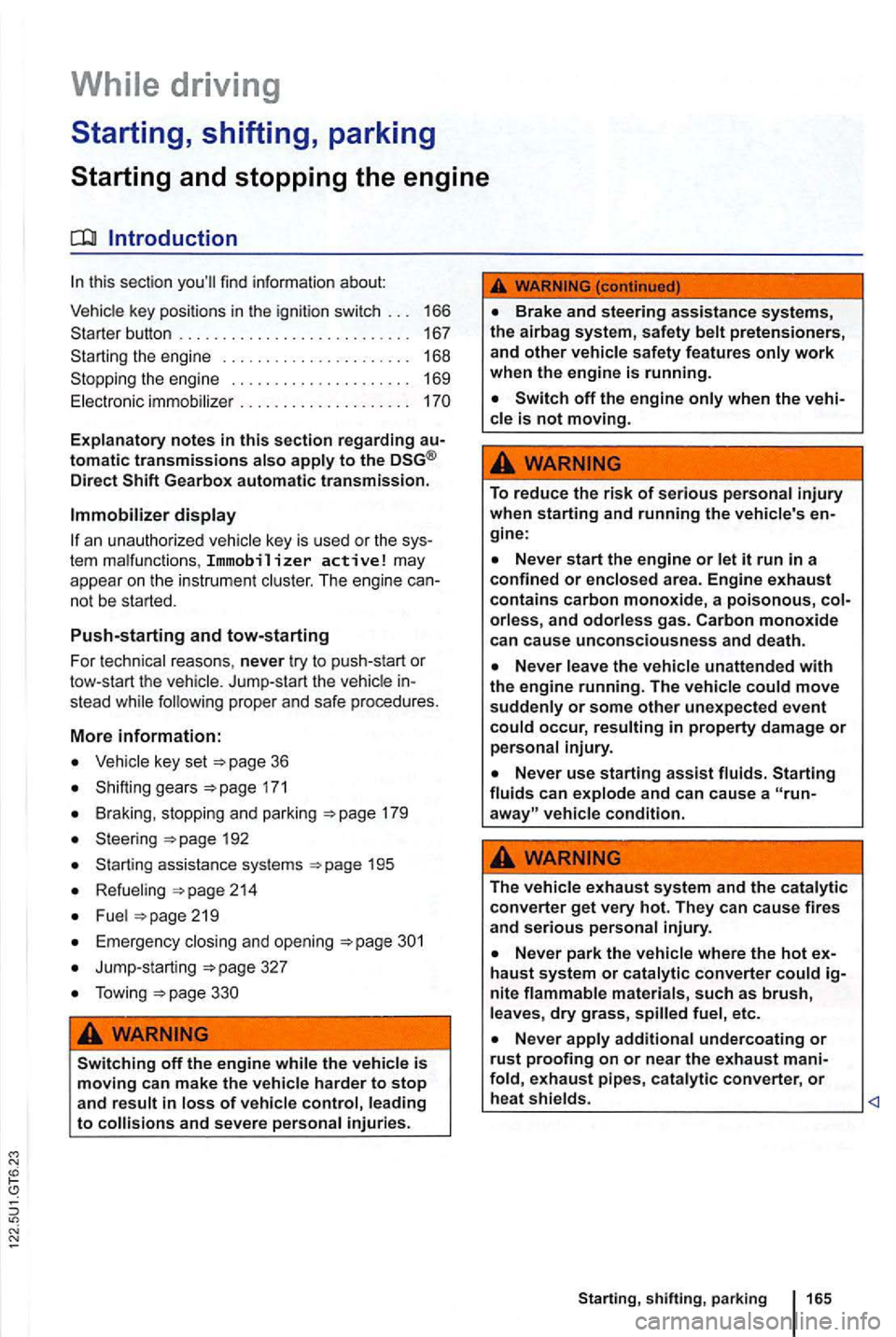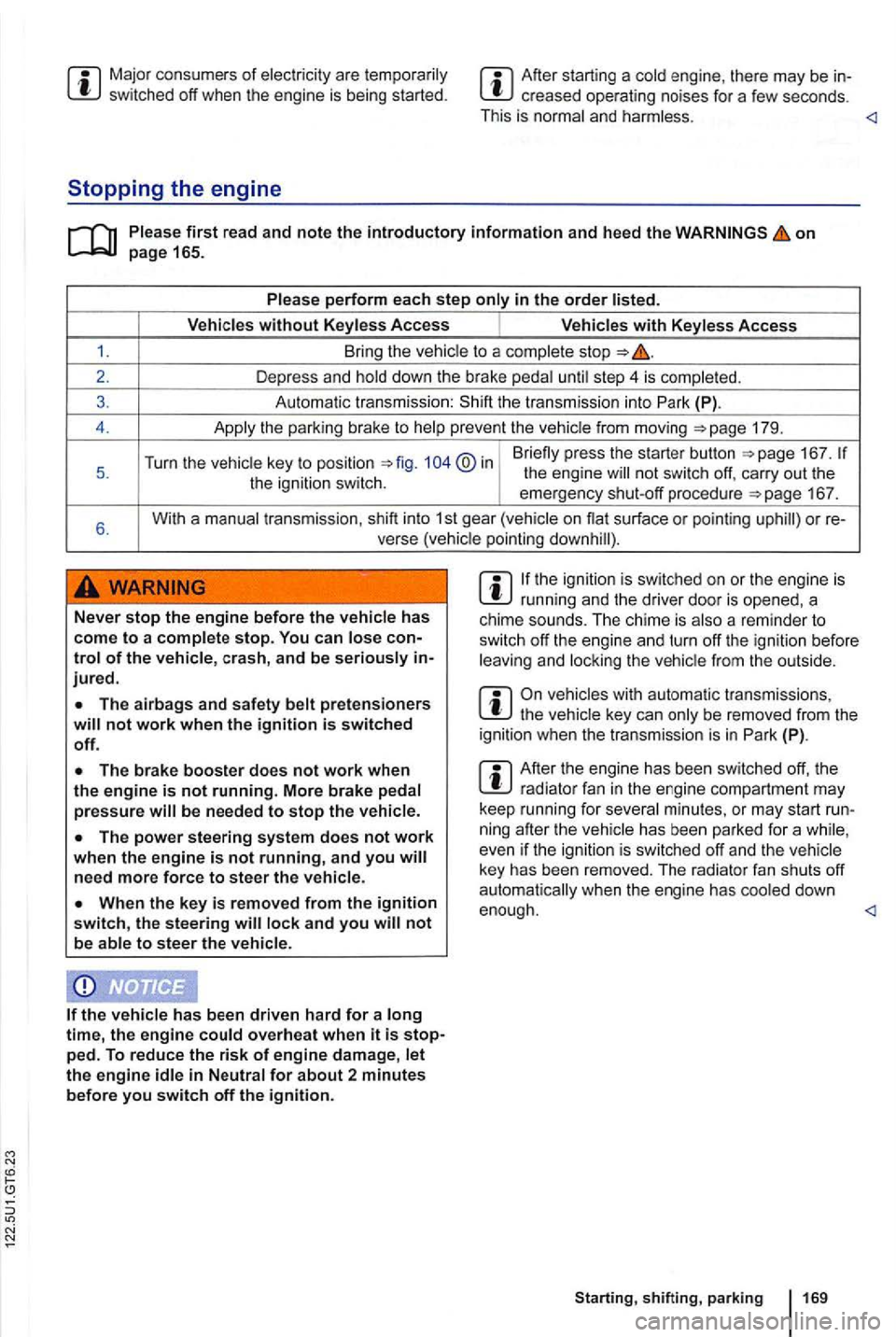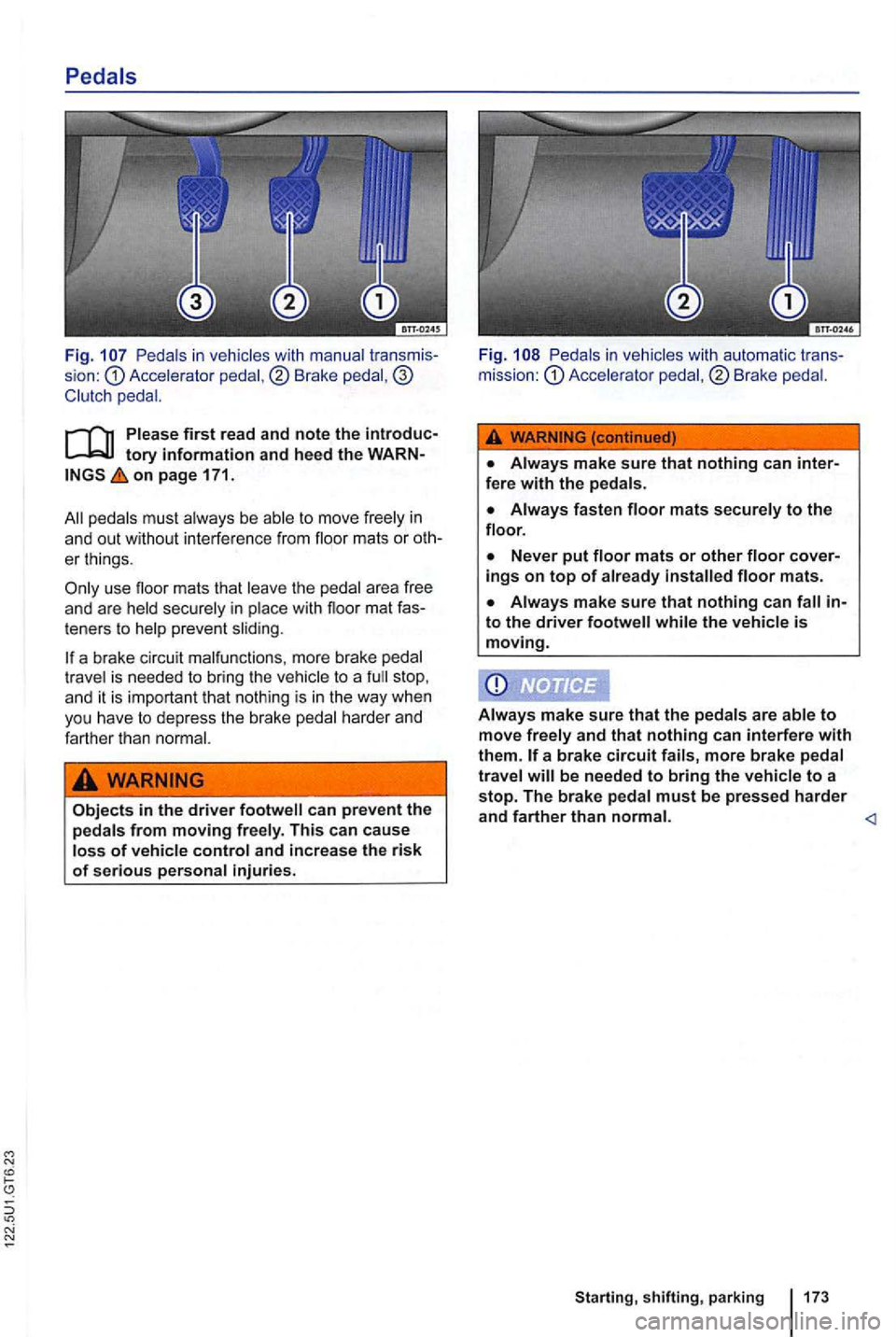2010 VOLKSWAGEN GOLF stop start
[x] Cancel search: stop startPage 264 of 516

Explanatory notes in this section regarding tomatic transmissions Direct
an unauthorized vehicle key is used or the sys
tem mal functions , Immobilizer active! may
appear on the instrument
stead wh ile following proper and safe procedures.
More information:
Vehicle key set
Shifting gears
Braking , stopp ing and parking =>page 179
Steering 192
Startin g assistance systems
Refueling =>page 214
Emergen cy clo sing and opening
Jump-starting
Towing
off the engine while the vehicle is moving can make the vehicle harder to stop and result in loss of vehicle control, leading to collisions and severe perso nal injurie s.
To reduce the risk of serious personal injury when starting and running the vehicle's gine:
shifting, parking 165
Page 268 of 516

Major con sumers of are sw itched off when the engine is being started .
Stopping the engine
After start ing a engin e, there may be creased operating noises fo r a few seconds .
This is
first read and note the introductory information and heed the on
perform each step
without Keyless Access Vehicles with Access
1. Bring the to a
2. Dep res s and down the brake s tep 4 is
3 . A ut omatic transmission: th e transmission into Park (P) .
4 .
the parking brake to fr om moving
in Briefly press the starter button 167. 5. the engine 167.
6 . With
a
tran smi ssion , shift into 1st gear or re-
ve rse pointin g down hill).
Never stop the engine before the has
come to a trol of the vehicle, crash, and be
be needed to stop the
not be able to steer the
the engine
running and the driver door is opened, a
c him e sounds. Th e c hime is a re minder to
sw itch off the engine and turn off the igniti on before and from the outside.
with automatic t ransmissio ns. the be remov ed from the
ignition when the transmission is in Park (P).
After the engi ne has been switched off. the radiato r fan in the engine compartment may
keep running for ning after the even if the ignition is sw itche d off and t he ve hicle
key has bee n remo ved. Th e radiat or fan sh uts off
automatically when th e engine has down
enough.
Starting, shifting, parking 169
Page 272 of 516

Pedals in vehicles with manual sion : Accele rator pedal ,® Brake
on page 171.
peda ls must always be able to move freely in
a n d out without interference from floor mats or oth
er thing s.
te ners to help preve nt slid ing.
a brake circu it malfunct ions, more brake pedal
tr ave l is needed to bring the ve hic le to a stop ,
and it is important that noth ing is in the way when
yo u have to depress the brake pedal harde r and
farth er than
Objects in the driver footwell can prevent the pedals from moving freely . This can cause loss of vehicle control and increase the risk of serious personal injuries. Fig.
Pedals
in vehicles with au tomatic Acce le rator pedal ,® Brake
a brake circuit fails, more brake pedal
travel will be needed to bring the vehicle to a
stop. The brake pedal must be pressed harder and farther than normal.
Starting, shifting, parking
Page 273 of 516

Manual transmission: Gearshift lever
Fig. Gea rshift pattern of a 6-speed manual
t r ansmission .
Please first read and note the introductory information and heed the o n page 171.
The positions of the
individua l gea rs are shown on
t he gearshift leve r
Depress the clutch pedal the way and hold.
Move the gearshift lever into the desired
Release the clutc h pedal to engage the gear.
T he c
lutch pedal must be
shift to the reverse gear when the vehic le
is not moving.
Depr ess the and hold
Move the gearshift lever to neutral and press
down .
Move the shift lever to the left and then push
f orward into the reverse gear position @.
Release the clut ch pedal to engage the gear .
Downshifting
You should always downshift gear by gear when
driving , meaning always in to the next lowes t gear. Do not downshift when the engine rpm (revo lutions
At fast speeds or high
engine rpms, skipping over one or more gears
when downshifting can cause damage to the clutch
and transmission, even
if a gear is not engaged
... -
Down shifting to a lowe r gear incorrectly can result in loss of vehicle control and can
cause accidents and serious personal inju-ries.
When the engine is running and a gear is en-
gaged, the vehic le will start to move as soon
as the c lutch pedal is released, even when
th e parking brake is applied. This a lso ap-plies when the parking brake is engaged.
Never shift into reverse when the vehicle
is moving.
Shifting
down to a gear that is too low when driving at fa st spee ds or high engine rpms can
cause extensive damage to the clutch and
transmission. That is true even if the clutch pedal is pressed so that the clutch is not
To help prevent damage and premature wear:
Do not rest your hand on the gearshift leve r
while driving. time, the pressure ca use premature wear in the transmission.
Make sure that the vehicle has come to a
comple te stop before shifti ng into reve rse.
Do not hold the vehicle on a hill using
Page 277 of 516

Remove your left foot from the brake => The accelera te from a stop at the maximum
rate .
you have accelerated , swi tch
weather, road, and traffic conditions permit and other drivers not be gered by your driving and the vehicle's
tory on page 171.
Emergency shift program
selec to r ment
of the forward gears.
some cases, vehicles with a Direct
is then impossible to drive
the vehicle backwards .
any event , have the automatic transmission
checked by an authorized
Overheating of Direct automatic transmission
The automa tic transmission may overheat ,
for example , due to frequent starts , extended o r stop-and-go traffic. Overheating is and, if by a text message in the in strument ditional warning chime may sound. and let the
tr ansmission coo l down =>
is switched off, when the road is slippery.
you have accelerated, switch back on again.
with the
wards. This can cause the automatic sion to overheat and be damaged.
in Neutral (N), not be lubricat-ed and be damaged .
the vehicle does not move in the desired tion , the system may not have engaged the drive
position Press the brake pedal and select the drive position again.
does not move in the desired rection , there is a system malfunctio n.
ther park the vehicle in a safe place or drive faster than 12 mph km/h) .
the tex t message and acoustic warning seconds or so, you must park the vehicle in a safe place as soon as you can safely do so and stop the engine .
L et the transmission cool down.
To help prevent damage to the sion, do not drive the vehicl e agai n until the
acoustic warning has s topped. As long as the
e ngine is overheated, avoid stop and start driv-ing and avoid low speed s pace") .
Page 278 of 516

Braking, stopping, and parking
this sectio n
Parking brake . . . . . . . . . . . 182
P arking . . . . . . . . . . . . . .
. . . . . . . . . . . . . . . . . 182
About the brakes . . . . . . . . . . . . . . . . . . . . . . . . 183
Braking assistance systems
Switching
L ock Brake System (ABS) . Br ak e Assist System
(BAS ), Ele ctronic Differential Lock (EDL), R eg ulatio n (ASR) and Electronic C ontrol
(ESC).
More information:
Trai ler towi ng 149
Starting assistance systems 1 95
Tires and whee ls 258
Driving with bad brakes or worn brake pads can cause a and serious personal
injury.
lights up in the instrument cluster display, whether alone or together with a text message, immediately contact an authorized Volkswagen dealer or authorized Facility to have the brake pads checked and, if necessa
ry, replaced .
Parking improperly can cause serious sonal injury.
lock and you
haust system or catalytic converter could
fu el, etc.
riously injure you and your passengers.
sonal injury.
mote control vehicle key, trapping passengers in the vehicle in an emergency. For ample, depending on the time of year, people trapp ed in the vehicle can be exposed to very high or very low temperatures.
children.
Starting, shifting, parking 179
Page 280 of 516

Lights cause or up
I
ES deactivated.
I Together with indicator malfunction .
T ogethe r with warning
or BRAKE:
Brake not dep ressed.
cause
I
The butt on in the is not
engaged .
When the ign ition is switch ed on,
text messages can cause the to break down in traffic and
or text WARN
stop the as soon as it is safe to do so.
Driving with bad brakes can cause a and serious
the brake warning BRAKE or does not go out, or comes on when driving, either the brake or there is a the as soon as you can do so and get expert assistance 187, Brake
fluid.
the brake warning comes on at the same time as the or the
187 . automatically
turns on when you turn the ignition on and off.
an authorized Volkswagen or an thorized Volkswage n The brake s work without
to
Adapt driving to
road conditions.
E ngage the Automatic
Lock
This up brake
you is safe to drive, drive and very authorized Volkswagen Service or other
spected. Avoid sudden hard braking and steering.
or does not go out, or if it comes on while driving, the system is not working can then be stopped with the
s tandard brakes (without not have the protection
thorized Volkswagen Service as soon as
Starting, shifting, parki ng 181
Page 281 of 516

Failure to heed warning lights or t ex t WARN-can result in vehicle damage .
Fig. 113 Between the front seats :
on page 179.
the parking brake lever up firmly.
When the ignition is on , the indicator or appears in the instrume nt c luster display to show th at the park ing brake is engaged
the leve r up 113 (arrow) .
While hold ing the release button down, move
t h e lever t he way down.
Parking
Ple ase firs t r ea d and note the introductory info rm ation and heed the WARNon pa ge 179.
note legal regulations when stopping and
parking your vehicle.
Parking the vehicle
p erform these steps only in the order listed.
the vehicle on a suitab le surface
the rear wheels are braked . Always
use the foot bra ke.
engag ed. This c an cause the brak e to over
heat and neg ati vely affec t the b rak e sys te m .
start to move even if the parking brake is e ngag ed .
Even
though the tra nsmission is in P ark (P),
t h e vehi cle may move a couple of inche s (a fe w
c entimeters) forwards or backwards if you take
your f oot off the brake pedal after stopping the
ve hicl e without fir s t firmly setting the parking
b rake .
A warning signal sounds if you drive faster
Apply t he parking brake to 182.
For automatic transmissions : (P).
Remove the vehicle key from the igni tion.
necessary , turn the steer ing whee l to
e ngage the steer ing column lock.